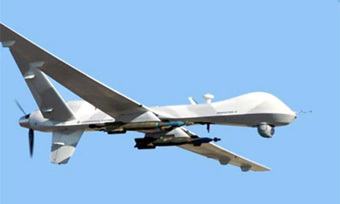onedomino
SCE to AUX
- Sep 14, 2004
- 2,677
- 482
- 98
This technology has fundamental long-range implications for the future of the Air Force. For example, how long before onboard USAF pilots are mostly history? 10 years? 20 years? It may be sooner than we guess:
USAF Predators come of age in Iraq and Afghanistan as Reaper waits in the wings
http://www.janes.com/defence/news/idr/idr061026_2_n.shtml
The General Atomics-Aeronautical Systems Inc (GA-ASI) Predator has already become the first unmanned aerial vehicle (UAV) to be adopted on a large scale by the US Air Force (USAF), the first operational UAV to be armed and the first to fire weapons in combat, and the first system to permit precision strike missions to be controlled from anywhere on the planet.
From July 2005 to June 2006, the USAF's Predators participated in more than 242 separate raids; engaged 132 troops in contact-force protection actions; fired 59 Hellfire missiles; surveyed 18,490 targets; escorted four convoys; and flew 2,073 sorties for more than 33,833 flying hours.
Meanwhile, the MQ-9A Reaper (formerly known as Predator B) is well under way. It is not just a bigger Predator. It is not only a different aircraft but does a different job. It is aimed directly against time-sensitive, fleeting targets, and Reaper squadrons will be attack squadrons. In short, the USAF wants an aircraft that can perform all the steps in its attack doctrine - find, fix, track, target, engage and assess - with no outside support except its datalink, and to move through those steps with a speed that matches that of the target.
Currently, the USAF plans to acquire nine Reaper systems, each with four combat-coded aircraft, and will acquire 60 air vehicles including spares. Under existing plans, the Reaper squadrons will be designated as attack squadrons, tasked with close air support, interdiction and special-operations support rather than intelligence, surveillance and reconnaissance.
Prim Reaper
The Reaper is nobody's toy aeroplane: at close quarters it is readily apparent that it is about as large as a Raytheon King Air business aircraft. It is four times heavier than the Predator and has almost nine times more installed power at take-off. It flies faster and twice as high, and it has more than twice the wing loading, translating into higher take-off and landing speeds. The structure is stiffer and the laminar-flow wing section is different; and the tail moment arm is relatively shorter, requiring much larger V-tails. The Reaper's V-tails are upright rather than inverted, because they would otherwise be too large to provide adequate ground clearance.
As with the Predator, the Reaper is largely made from carbon fibre composite material. Most of the skins are sandwich-type, with two carbon fibre face sheets bonded to a core of Rohacell foam or Nomex honeycomb, and are inherently rigid enough that the internal structure of carbon fibre spars and ribs can be very simple.
Some Reapers have already been assigned to other users, some of them sensitive. The US Department of Homeland Security Customs and Border Patrol (CBP) ordered one MQ-9 on 1 September 2005. According to the CBP, it had detected almost 1,900 targets and had been instrumental in 1,246 arrests, including the seizure of seven tons of marijuana. CBP has gone on to take delivery of a second aircraft, at the end of September 2006, and has ordered two more aircraft for delivery in late 2007.
The UK is preparing to order two Reaper air vehicles and a ground control station for operations in Afghanistan. The USD77 million order was submitted for Congressional approval in September and the aircraft are expected in service in 2007


